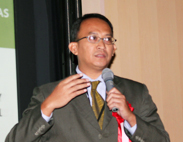Events
EXPLORING NEW PARADIGMS OF SOCIAL SAFETY AND HUMAN SECURITY
-Lessons learned from the 2011 Great East Japan Earthquake and Tsunami-
Date: November 22, 2011 (9:30-17:00)
Venue: Campus Plaza Kyoto (5th Floor - First Lecture Room), Japan
Organized by:
Kyoto University Global COE Program "Global Center for Education and Research on Human Security Engineering for Asian Megacities"
Co-organized by:
Disaster Prevention Research Institute, Kyoto University
Supported by::
Yomiuri Shimbun Osaka, Kyoto Convention Bureau
The detailed information is here.
The video of the symposium is here.
Number of attendants: 150
Report 188
Outline
The purpose of this symposium was to share lessons learned from the Great East Japan Earthquake and from disaster recovery experiences in Asia from the standpoint of urban human security engineering, as well as to explore new paradigms of safety and security in preparation for future events such as simultaneous earthquakes in the Tokai, Tonankai, and Nankai regions, and of new research, human resources development, and practical science that are required to provide urban human security engineering.
Report
The symposium started with opening remarks by Prof. Masayoshi Nakashima (Director, Disaster Prevention Research Institute, Kyoto University) and by the event organizer, Prof. Yuzuru Matsuoka (Leader of Global COE “Global Center for Education and Research on Human Security Engineering for Asian Megacities”), followed by a keynote speech by Prof. Liang-Chun Chen (Director, National Science and Technology Center for Disaster Reduction, Taiwan) titled “Natural Disaster Risk Governance: Towards Social Safety and Human Security.”
In Part 1 “Lessons Learned from the Great East Japan Earthquake,” under Prof. Tomoharu Hori (DPRI, Kyoto University) as chair, seven faculty members of Kyoto University presented reports about the Great East Japan Earthquake through various perspectives, namely damage to infrastructures, tsunami inundation simulations, the relationship between tsunami warning system and evacuation behaviors, information sharing using Information Communication Technology, disaster debris management, recovery of cities and villages, and engineering technologies aimed at mitigating human casualties.
Part 2 “Lessons Learned from Disasters in Asian Regions” invited Mr. Shigeru Sugawara (Mayor of Kesennuma City, Miyagi Prefecture) and Mr. Hanief Arie (Deputy of Head, Indonesian President’s Delivery Unit for Development Monitoring and Oversight) to deliver keynote speeches about their practical experiences in the process of disaster recovery.
Part 3 “New Paradigm of Social Safety and Human Security” comprised a panel discussion with Prof. Hirokazu Tatano (DPRI, Kyoto University) as moderator and Mr. Tomio Saito (Administrative Director, Hyogo International Association), Mr. Motoaki Ue (Crisis Management Supervisor, Wakayama Prefecture), Mr. Shigeru Sugawara, and Assoc. Prof. Rajib Shaw (Graduate School of Environmental Studies, Kyoto University) as panelists. The members shared the issues of urban crisis management drawing on their experience in the Great East Japan Earthquake, the 1955 Great Hanshin Earthquake, and the landslides caused by heavy rain in Wakayama in 2009, and discussed the challenges of preparing for future events such as simultaneous earthquakes in the Tokai, Tonankai, and Nankai regions. Finally, Prof. Hiroyasu Ohtsu (Vice Dean, Graduate School of Engineering, Kyoto University) gave closing remarks on the role of universities as educational institutions.
The symposium attracted many residents for participation numbering some 150. Questions were asked throughout the event, indicating a keen interest in the subjects discussed.

